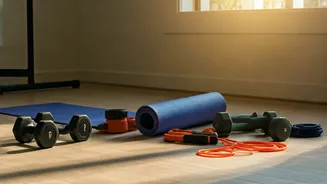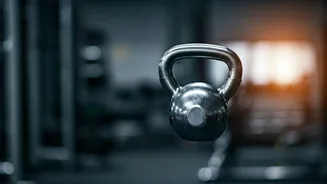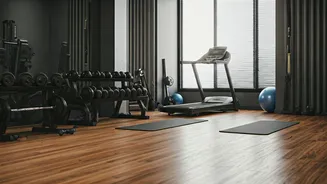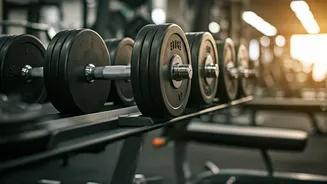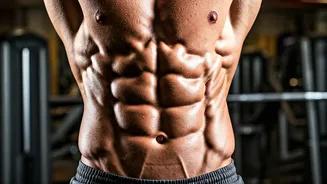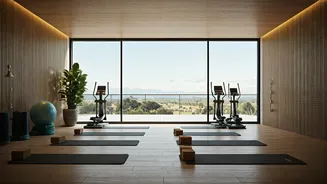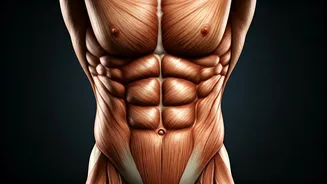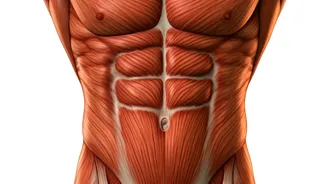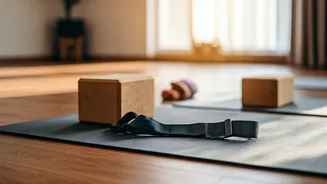Setting Fitness Goals
Before diving into home workouts, setting clear goals is paramount. Defining your objectives, whether it's weight loss, muscle gain, or improved endurance,
provides the motivation needed to stay consistent. Start by realistically assessing your current fitness level and identify areas for improvement. This self-assessment aids in choosing the appropriate exercises and intensity levels. Consider incorporating the SMART goal-setting framework: Specific, Measurable, Achievable, Relevant, and Time-bound. For instance, instead of aiming to 'get fit', set a goal like 'I will run for 30 minutes, three times a week, to improve my cardiovascular health' or 'I want to be able to do 10 push-ups in a month.' Keeping these goals written down can help you track your progress. Ensure your goals align with your lifestyle and physical capabilities to increase the likelihood of success.
Bodyweight Exercises Essentials
Bodyweight exercises are the cornerstones of effective home workouts. These exercises require no equipment and use your body weight as resistance, making them accessible and adaptable. Begin with fundamental movements like push-ups, squats, lunges, planks, and crunches. Push-ups target the chest, shoulders, and triceps; squats work the legs and glutes; lunges enhance balance and leg strength; planks strengthen the core; and crunches focus on the abdominal muscles. Start with a manageable number of repetitions and sets, gradually increasing them as your strength improves. Aim for 2-3 sets of 10-15 repetitions for each exercise, allowing for a short rest period between sets. Proper form is crucial to prevent injuries and maximize the effectiveness of each exercise. Watch instructional videos or seek guidance from online resources to ensure you’re performing the movements correctly. Consistency in practicing these exercises will result in increased strength, endurance, and overall fitness.
Incorporating Cardio Workouts
Cardiovascular exercises are crucial for heart health and calorie burning. Several cardio workouts can be done at home without equipment. Jumping jacks, high knees, burpees, and mountain climbers are all highly effective at elevating your heart rate and providing a great cardiovascular workout. Incorporate these exercises into your routine for a minimum of 20-30 minutes, three to five times a week. Warm up before each cardio session with dynamic stretches like arm circles and leg swings to prepare your muscles for exercise. Varying your cardio routines prevents boredom and keeps your body challenged. For instance, combine a brisk walking session with short intervals of high-intensity exercises such as sprinting on the spot, to enhance both endurance and fat burning. If you have access to a jump rope, that can also be a simple and fun way to get your heart rate up, or you can even put on music and dance for at least 20 minutes.
Creating Workout Schedule
Establishing a consistent workout schedule is key to achieving long-term fitness goals. Plan your workouts in advance and treat them as important appointments. Begin by scheduling your workouts for specific days and times that align with your daily routine and energy levels. Schedule your exercises based on the time you have and your fitness goals. If you have a busy week, aim for shorter, more frequent workouts rather than trying to fit in longer sessions that may be unsustainable. This allows you to fit workouts around other commitments and fosters consistency. Consider a weekly schedule that includes a mix of strength training and cardio exercises, complemented by rest days to allow your muscles to recover. Make use of online calendar applications or even a simple planner. A well-structured schedule improves motivation and increases your chances of sticking to your fitness plan. Adjust your workout plan as needed. Staying consistent means you will keep improving, so if there is a day that you don’t feel well, don’t push yourself too hard, rather rest and restart from the next day.
Importance of Nutrition
Nutrition plays a critical role in supporting your fitness efforts. A balanced diet fuels your body for workouts, aids in muscle recovery, and contributes to weight management. Focus on consuming whole, unprocessed foods like fruits, vegetables, lean proteins, and whole grains. These foods provide essential nutrients, including vitamins, minerals, and fiber. Ensure you're eating a sufficient amount of protein to support muscle repair and growth, especially after strength-training sessions. Drink plenty of water throughout the day, as hydration is essential for overall health and performance. Limit your intake of sugary drinks, processed foods, and excessive amounts of unhealthy fats. Instead of rigid diets, consider making small, sustainable changes to your eating habits. This can include swapping sugary snacks for fruits or adding a protein shake after your workout. Create a meal plan for the week, which will make it easier to eat healthy, and this consistency makes the fitness journey less demanding. By combining a balanced diet with regular exercise, you’ll maximize the benefits of your home workout.
Home Workout Equipment
While bodyweight exercises require no equipment, incorporating basic equipment can enhance the variety and effectiveness of your workouts. Resistance bands are affordable and versatile tools that can be used to add resistance to a wide range of exercises. They come in various resistance levels, allowing you to gradually increase the intensity of your workouts. A yoga mat provides a comfortable surface for floor exercises and helps protect your joints. Dumbbells are another option for resistance training, available in various weights to suit your strength levels. A set of dumbbells allows you to target different muscle groups with a variety of exercises. Stability balls are also a good addition for core strength and balance exercises. If space permits, consider a pull-up bar, which is a great tool for building upper-body strength. Start with a few essential pieces of equipment and add more as you progress and your needs change. Research the available equipment to make the choices that best align with your fitness goals and available space. Investing in equipment can make your workouts more interesting and challenging, but remember that many of the same benefits can be achieved with bodyweight exercises.
Staying Motivated Long-Term
Maintaining motivation is essential for long-term success in your home fitness journey. It's common to lose enthusiasm, so having strategies to stay engaged will help you stick to your routine. One effective strategy is to set realistic goals. Break down your larger goals into smaller, achievable milestones. This approach makes your progress feel tangible and motivates you to keep going. Track your workouts and progress, whether through a fitness app, a journal, or a simple spreadsheet. Seeing your improvements over time can be a powerful motivator. Find an exercise buddy to workout with, whether in person or online. Having someone to share your fitness journey with can provide accountability, support, and encouragement. If you enjoy music, create playlists to accompany your workouts. This can make the exercise more enjoyable. Reward yourself for achieving your fitness goals. This could be anything from buying new workout gear to treating yourself to a relaxing activity like a massage. Embrace setbacks as learning opportunities. Everyone experiences moments where their progress stalls. If you miss a workout or deviate from your routine, don’t be discouraged. Get back on track as soon as possible. Focus on what you have accomplished, rather than what you haven’t, and adjust your plan as necessary.
